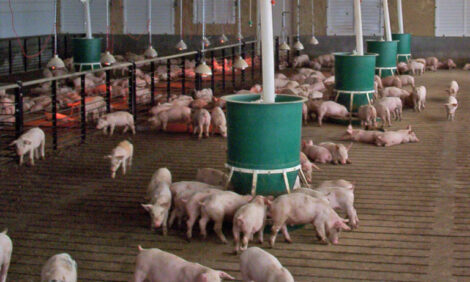



USDA Quarterly Pigs and Hogs Report: March 2003
This months quarterly Hogs and Pigs report from the USDA's National Agricultural Statistics Service. The article provides the report text and graphs, and helps explain what it all means. Link also to the full PDF report.| Introduction |
This document aims to pull together, in one place of reference, all the various information generated by the USDA Quarterly report. This document includes: USDA Quarterly report: March 2003
What it all means
Graph data from the report Hog Inventories by State (December 2001) For a PRINTABLE VERSION of the full 30 page report in PDF format, including all the tabular data which is not shown in this article, Click Here
| Pigs & Hogs Report: March 2003 |
U.S. inventory of all hogs and pigs on March 1, 2003, was 58.1 million head. This was 2 percent below March 1, 2002, and 2 percent below December 1, 2002.
Breeding inventory, at 5.96 million head, was down 4 percent from March 1, 2002, and down 1 percent from last quarter.
Market hog inventory, at 52.2 million head, was 2 percent below last year and 3 percent below last quarter.
The December 2002-February 2003 U.S. pig crop, at 24.4 million head, was 2 percent less than 2002, and 2 percent more than 2001. Sows farrowing during this period totaled 2.77 million head, 2 percent below last year.
Sows farrowed during this quarter represented 46 percent of the breeding herd.
Average pigs per litter was 8.81 pigs saved per litter for the December 2002-February 2003 period, compared to 8.74 last year.
Pigs saved per litter by size of operation ranged from 7.60 for operations with 1-99 hogs to 8.90 for operations with more than 5,000 hogs and pigs.
March 1

U.S. hog producers intend to have 2.84 million sows farrow during the March-May 2003 quarter, 3 percent below the actual farrowings during the same period in 2002, and 1 percent below 2001.
Intended farrowings for June-August 2003, at 2.79 million sows, are 3 percent below the same period in both 2002 and 2001.
The total number of hogs under contract, owned by operations with over 5,000 head, but raised by contractees, accounted for 35 percent of the total U.S. hog inventory, up from 31 percent last year.
Revisions
| What it all means? |
What the commentators and industry thinkers read into this data:
Commentary on the Quarterly Report - Ron Plain
|
| Graph Data from the Report |
Dec 2002 - Feb 2003

US Pigs Per Litter
By Size of Operation: Dec 2002 - Feb 2003

US Quarterly Sows Farrowed
Dec 2002 - Feb 2003

US Quarterly Pig Crop
Dec 2002 - Feb 2003


June 1 - Hog Inventory and Market Hogs (US)

September 1 - Hog Inventory and Market Hogs (US)

December 1 Hog Inventory and Market Hogs (US)

Reliability of March 1 Hogs and Pigs Estimates
Survey Procedures: A random sample of roughly 12,100 U.S. producers was surveyed to provide data for these estimates. Survey procedures ensured that all hog and pig producers, regardless of size, had a chance to be included in the survey. Large producers were sampled more heavily than small operations. Data were collected from about 9,800 operations, 81 percent of the total sample, during the first-half of March by mail, telephone, and face-to-face personal interviews. Regardless of when operations responded, they were asked to report inventories as of March 1.Estimation Procedures: These hogs and pigs estimates were prepared by the Agricultural Statistics Board after reviewing recommendations and analysis submitted by each State office. National and State survey data were reviewed for reasonableness with each other and with estimates from past years using a balance sheet. The balance sheet begins with the previous inventory estimate, adds the estimates of births and imports, and subtracts the estimates of slaughter, exports, and deaths. This indicated ending inventory level is compared to the Agricultural Statistics Board estimate for reasonableness.
Revision Policy: Revisions to previous estimates are made to improve quarter to quarter relationships. Estimates for the previous four quarters are subject to revision when current estimates are made. In December, estimates for all quarters of the current and previous year are reviewed. The reviews are primarily based on hog check-off receipts and slaughter. Estimates will also be reviewed after data from the Department of Agriculture five-year Census of Agriculture are available. No revisions will be made after that date.
Reliability: Since all operations raising hogs are not included in the sample, survey estimates are subject to sampling variability. Survey results are also subject to non-sampling errors such as omissions, duplication, and mistakes in reporting, recording, and processing the data. The affects of these errors cannot be measured directly. They are minimized through rigid quality controls in the data collection process and through a careful review of all reported data for consistency and reasonableness.
To assist users in evaluating the reliability of the estimates in this report, the "Root Mean Square Error" is shown for selected items in the following table. The "Root Mean Square Error" is a statistical measure based on past performance and is computed using the difference between first and final estimates. The "Root Mean Square Error" for hog inventory estimates over the past 20 quarters is 1.0 percent. This means that chances are 2 out of 3 that the final estimate will not be above or below the current estimate of 58.1 million head by more than 1.0 percent. Chances are 9 out of 10 that the difference will not exceed 1.8 percent.
Source: Quarterly Hogs and Pigs Report, March 2003 - USDA National Agricultural Statistics Service









